Loại bỏ chất thải nhựa trôi nổi trên sông tại Việt Nam: Kết quả sơ bộ cho trường hợp nghiên cứu tại thành phố Cần Thơ
Tóm tắt:
Nghiên cứu này tập trung vào việc loại bỏ chất thải nhựa trên hệ thống sông nước Đồng bằng sông
Cửu Long. Rất nhiều chất thải nhựa trôi nổi bao gồm có thể tái chế PET và LDPE, và rất nhiều PS đã
được tìm thấy trên hệ thống sông/kênh, dẫn đến việc khó tái chế và gây độc cho môi trường. Nghiên cứu
này đã đánh giá và phân tích các dữ liệu khác nhau về chất thải nhựa trong hệ thống sông nước của thành
phố Cần Thơ, dựa trên câu hỏi nghiên cứu: Làm thế nào và ở đâu có thể thu gom được chất thải nhựa ở
thành phố Cần Thơ? Và giải pháp thu gom nào là hiệu quả và hữu dụng nhất? Dữ liệu chủ yếu được thu
thập từ các cuộc trao đổi với các bên liên quan, khảo sát thực địa và nghiên cứu tài liệu. Ngoài ra, để xác
định vị trí đặt hệ thống thu gom (giải pháp kỹ thuật), số liệu thủy văn đã được đo đạc và so sánh với dữ
liệu trước đó.
Từ khóa: Chất thải nhựa, chất thải nhựa vĩ mô nổi, lưu vực nhựa, thành phố Cần Thơ
Abstract:
This study focuses on removing plastic waste from the water system of the Mekong delta. Many
kinds of the floating macro plastic waste in the canals including the recyclable PET and LDPE, also a
lot of PS were found that may lead to be hard to recycle and toxic to the environment. This research
evaluated and analyzed different data about the plastic waste in the water system of Can Tho city, based
on the research question of: How and where can floating macro plastic waste be caught in Can Tho city?
And what is the most efficient and effective way to achieve this? Mainly the data was collected from
meetings with stakeholders involved, field observations and extensive desk research. Furthermore, to
determine the placement of the catchers (technical measure), hydrological measurements was conducted
and compared with previous data.
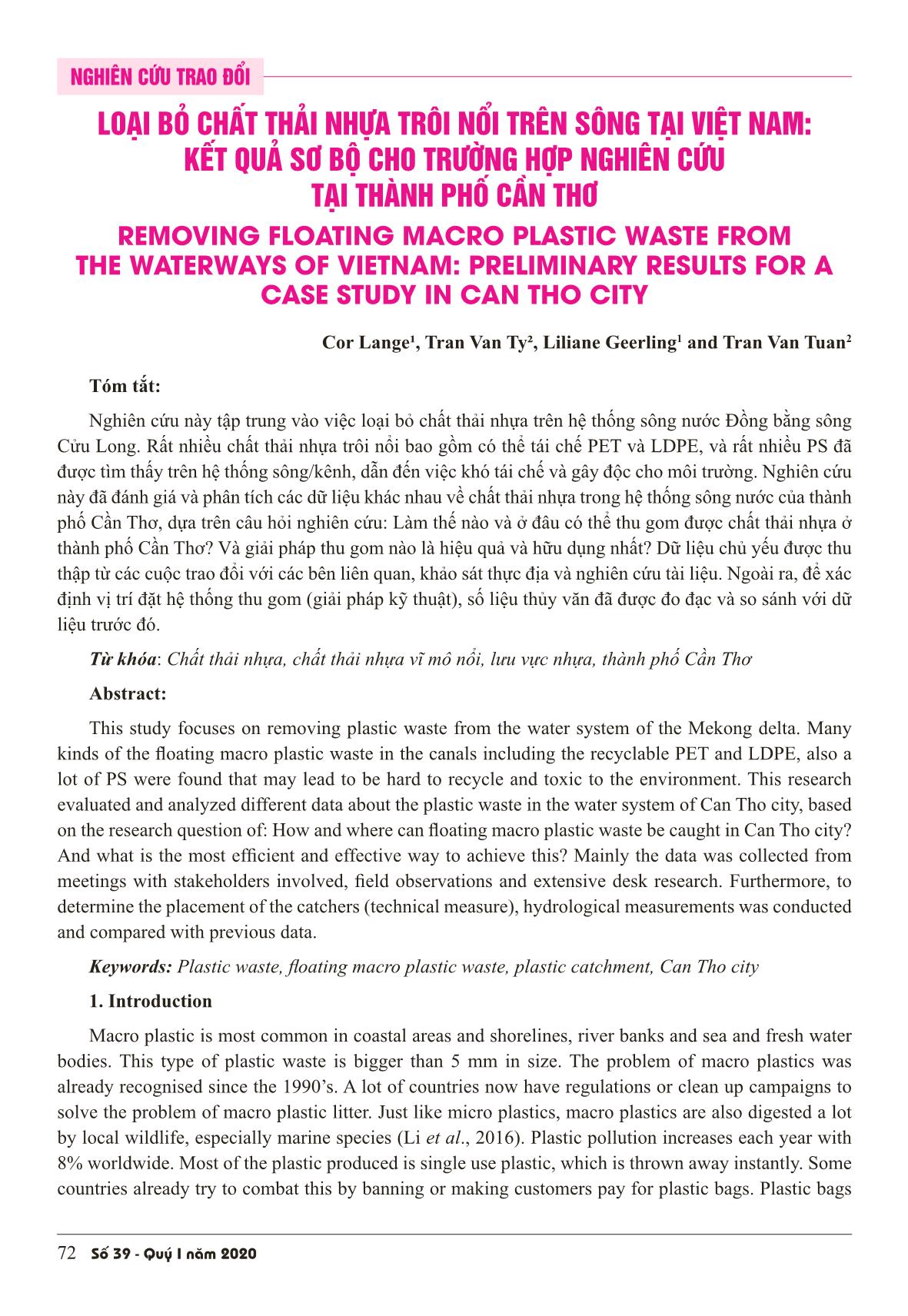
Trang 1
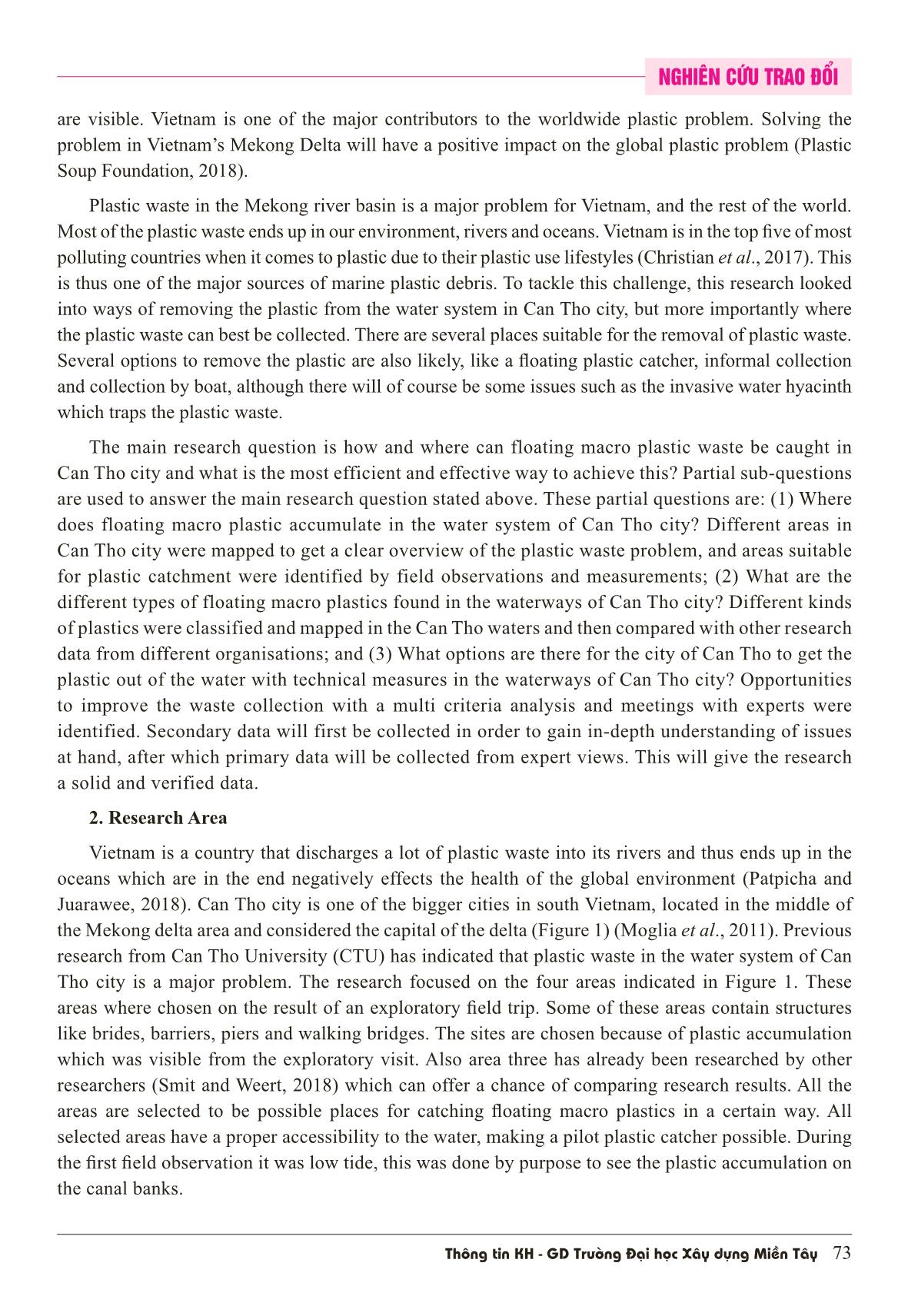
Trang 2
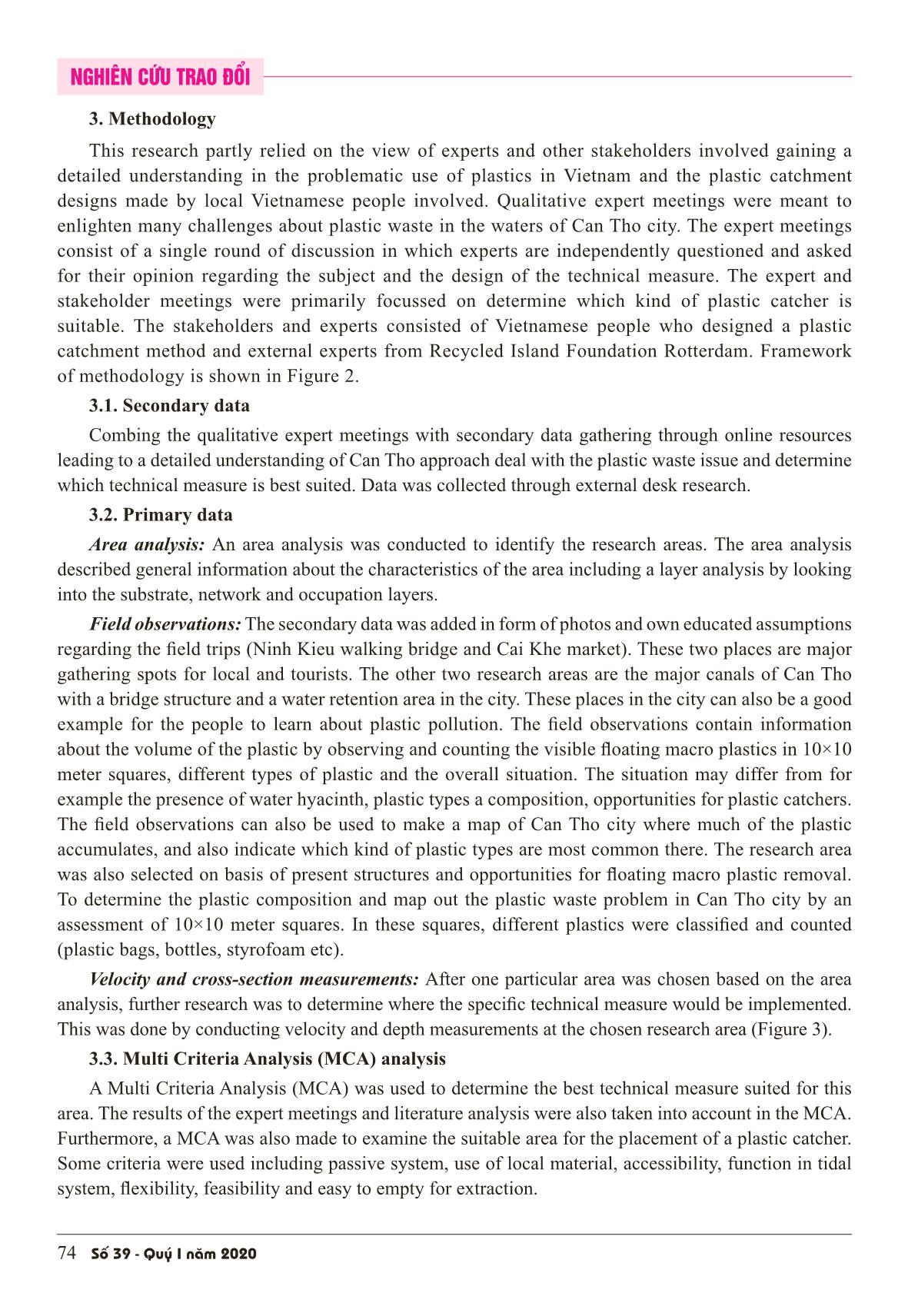
Trang 3
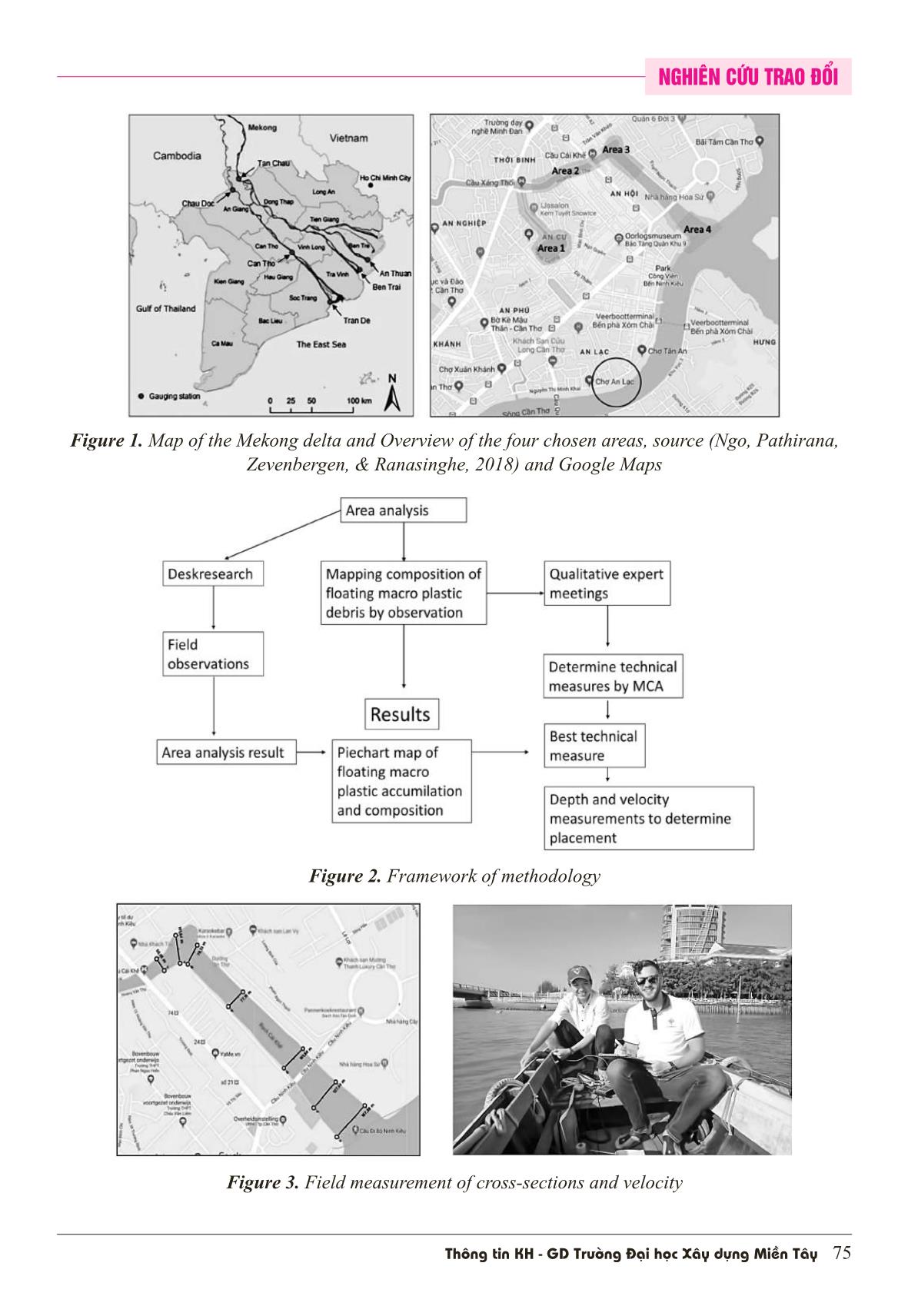
Trang 4
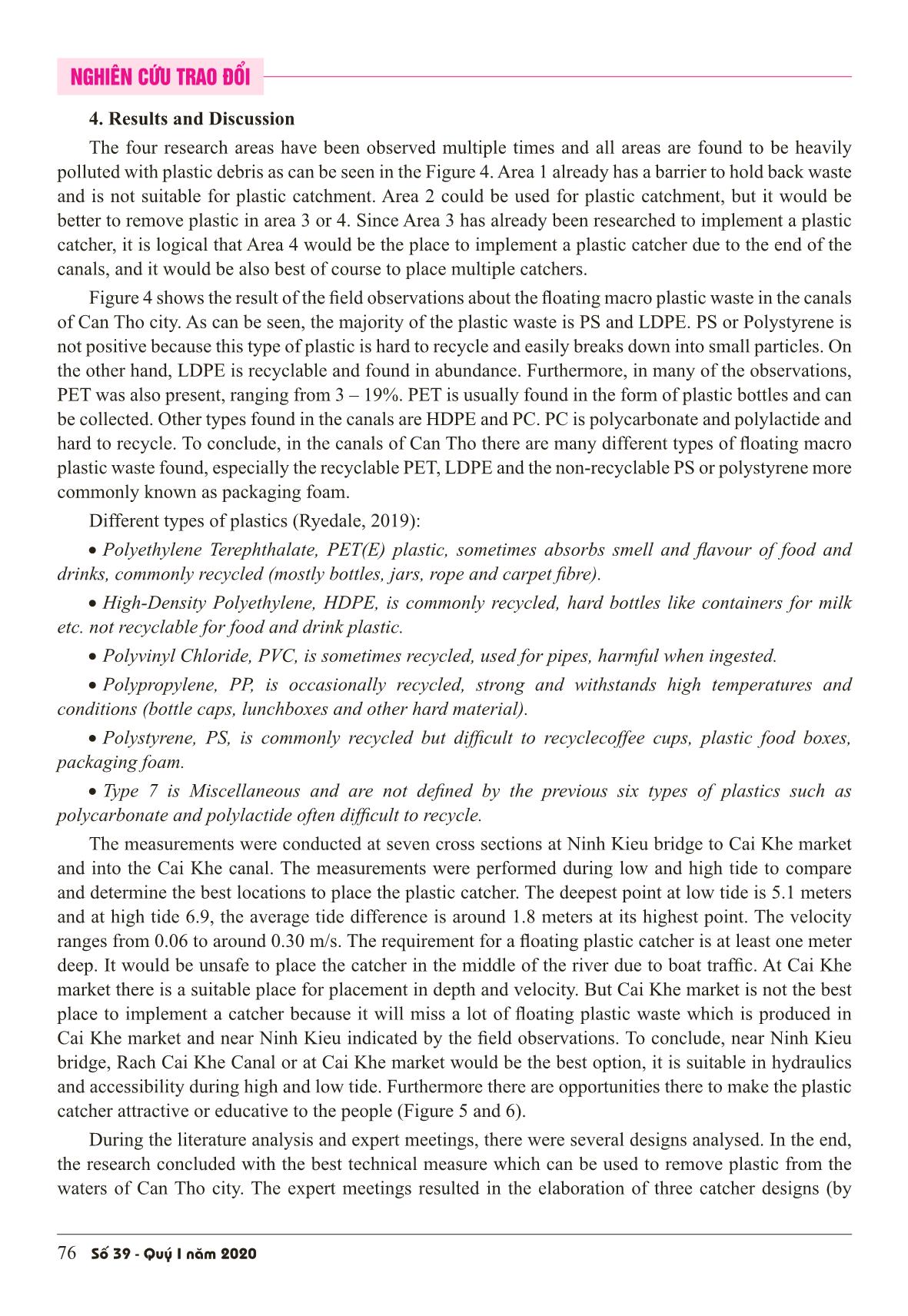
Trang 5
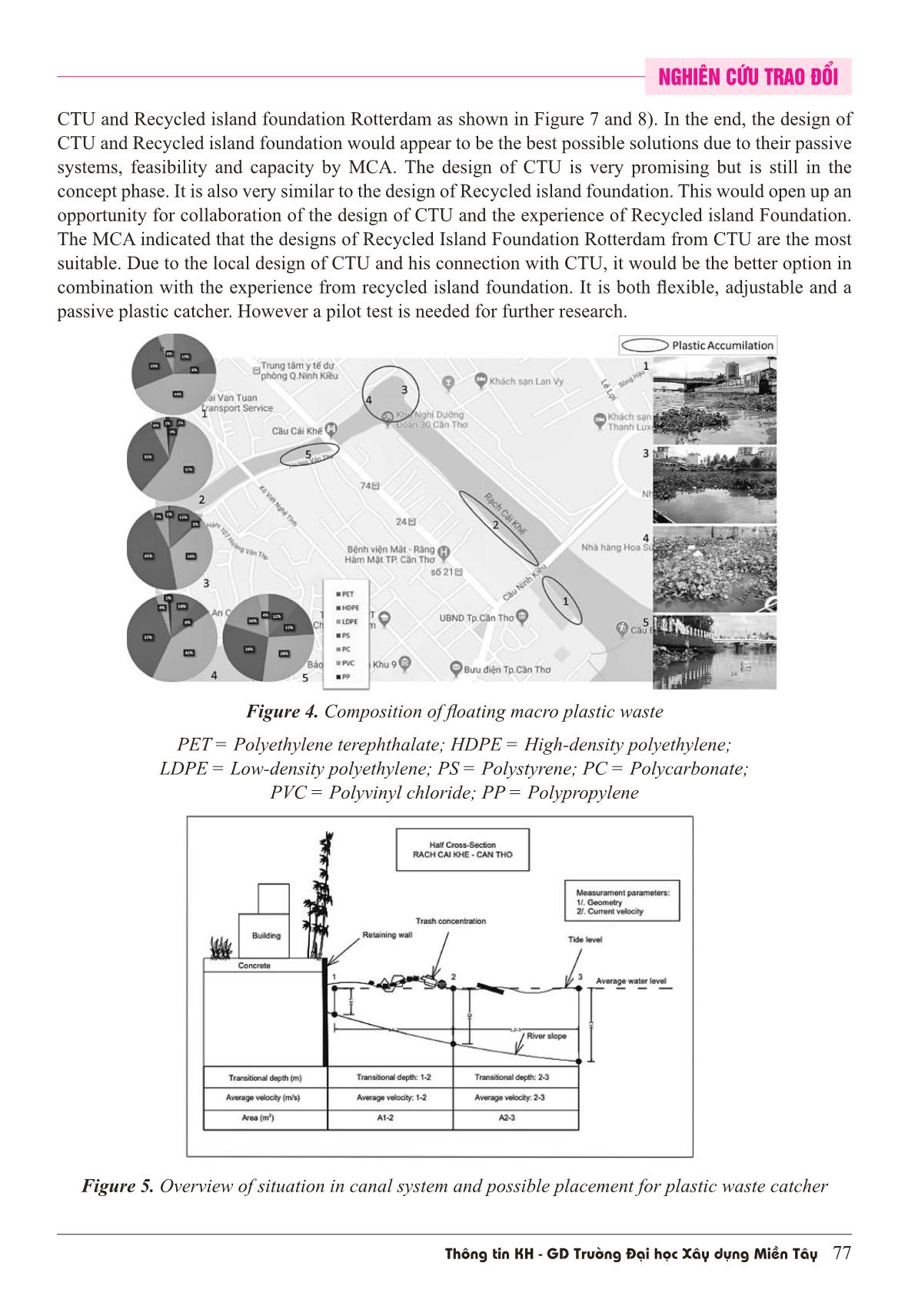
Trang 6
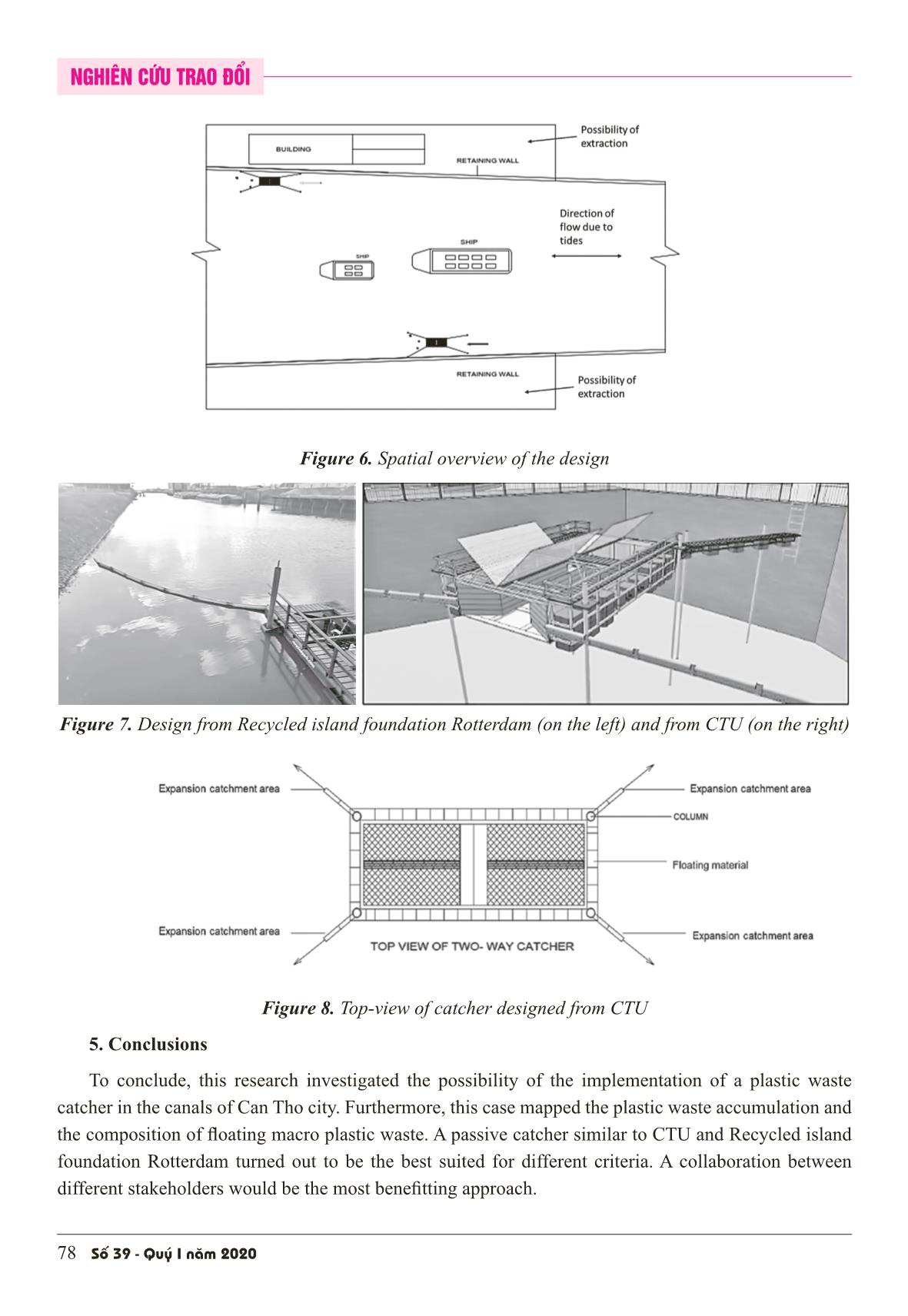
Trang 7
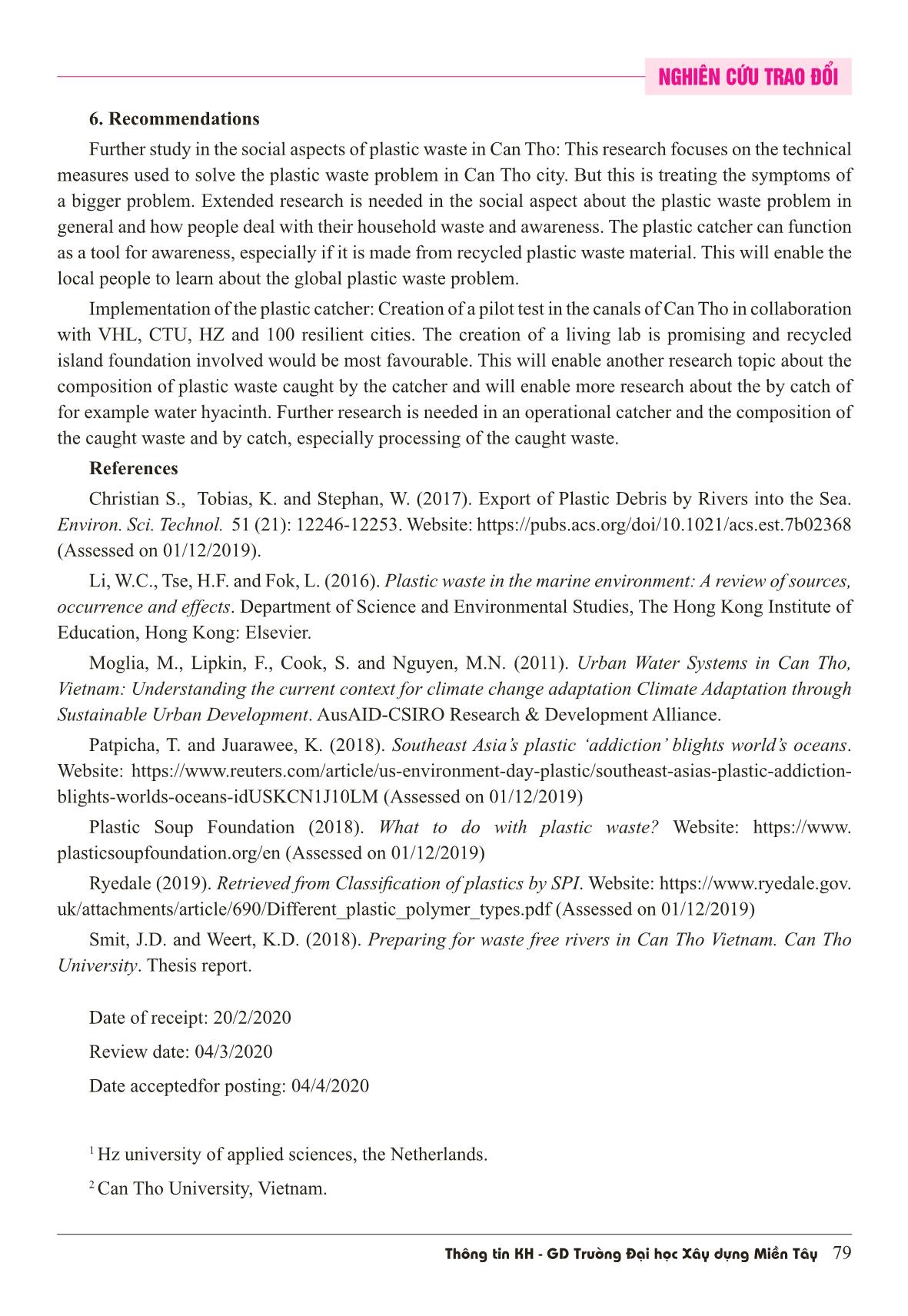
Trang 8
Tóm tắt nội dung tài liệu: Loại bỏ chất thải nhựa trôi nổi trên sông tại Việt Nam: Kết quả sơ bộ cho trường hợp nghiên cứu tại thành phố Cần Thơ
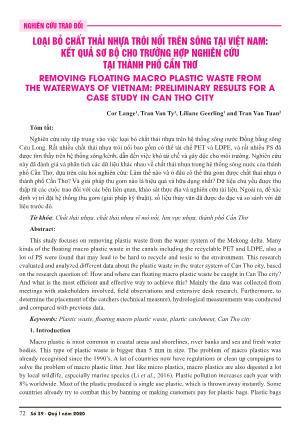
Soá 39 - Quyù I naêm 202072 NGHIÊN CỨU TRAO ĐỔI LOẠI BỎ CHẤT THẢI NHỰA TRÔI NỔI TRÊN SÔNG TẠI VIỆT NAM: KẾT QUẢ SƠ BỘ CHO TRƯỜNG HỢP NGHIÊN CỨU TẠI THÀNH PHỐ CẦN THƠ REMOVING FLOATING MACRO PLASTIC WASTE FROM THE WATERWAYS OF VIETNAM: PRELIMINARY RESULTS FOR A CASE STUDY IN CAN THO CITY Cor Lange¹, Tran Van Ty², Liliane Geerling1 and Tran Van Tuan2 Tóm tắt: Nghiên cứu này tập trung vào việc loại bỏ chất thải nhựa trên hệ thống sông nước Đồng bằng sông Cửu Long. Rất nhiều chất thải nhựa trôi nổi bao gồm có thể tái chế PET và LDPE, và rất nhiều PS đã được tìm thấy trên hệ thống sông/kênh, dẫn đến việc khó tái chế và gây độc cho môi trường. Nghiên cứu này đã đánh giá và phân tích các dữ liệu khác nhau về chất thải nhựa trong hệ thống sông nước của thành phố Cần Thơ, dựa trên câu hỏi nghiên cứu: Làm thế nào và ở đâu có thể thu gom được chất thải nhựa ở thành phố Cần Thơ? Và giải pháp thu gom nào là hiệu quả và hữu dụng nhất? Dữ liệu chủ yếu được thu thập từ các cuộc trao đổi với các bên liên quan, khảo sát thực địa và nghiên cứu tài liệu. Ngoài ra, để xác định vị trí đặt hệ thống thu gom (giải pháp kỹ thuật), số liệu thủy văn đã được đo đạc và so sánh với dữ liệu trước đó. Từ khóa: Chất thải nhựa, chất thải nhựa vĩ mô nổi, lưu vực nhựa, thành phố Cần Thơ Abstract: This study focuses on removing plastic waste from the water system of the Mekong delta. Many kinds of the floating macro plastic waste in the canals including the recyclable PET and LDPE, also a lot of PS were found that may lead to be hard to recycle and toxic to the environment. This research evaluated and analyzed different data about the plastic waste in the water system of Can Tho city, based on the research question of: How and where can floating macro plastic waste be caught in Can Tho city? And what is the most efficient and effective way to achieve this? Mainly the data was collected from meetings with stakeholders involved, field observations and extensive desk research. Furthermore, to determine the placement of the catchers (technical measure), hydrological measurements was conducted and compared with previous data. Keywords: Plastic waste, floating macro plastic waste, plastic catchment, Can Tho city 1. Introduction Macro plastic is most common in coastal areas and shorelines, river banks and sea and fresh water bodies. This type of plastic waste is bigger than 5 mm in size. The problem of macro plastics was already recognised since the 1990’s. A lot of countries now have regulations or clean up campaigns to solve the problem of macro plastic litter. Just like micro plastics, macro plastics are also digested a lot by local wildlife, especially marine species (Li et al., 2016). Plastic pollution increases each year with 8% worldwide. Most of the plastic produced is single use plastic, which is thrown away instantly. Some countries already try to combat this by banning or making customers pay for plastic bags. Plastic bags Thoâng tin KH - GD Tröôøng Ñaïi hoïc Xaây döïng Mieàn Taây 73 NGHIÊN CỨU TRAO ĐỔI are visible. Vietnam is one of the major contributors to the worldwide plastic problem. Solving the problem in Vietnam’s Mekong Delta will have a positive impact on the global plastic problem (Plastic Soup Foundation, 2018). Plastic waste in the Mekong river basin is a major problem for Vietnam, and the rest of the world. Most of the plastic waste ends up in our environment, rivers and oceans. Vietnam is in the top five of most polluting countries when it comes to plastic due to their plastic use lifestyles (Christian et al., 2017). This is thus one of the major sources of marine plastic debris. To tackle this challenge, this research looked into ways of removing the plastic from the water system in Can Tho city, but more importantly where the plastic waste can best be collected. There are several places suitable for the removal of plastic waste. Several options to remove the plastic are also likely, like a floating plastic catcher, informal collection and collection by boat, although there will of course be some issues such as the invasive water hyacinth which traps the plastic waste. The main research question is how and where can floating macro plastic waste be caught in Can Tho city and what is the most efficient and effective way to achieve this? Partial sub-questions are used to answer the main research question stated above. These partial questions are: (1) Where does floating macro plastic accumulate in the water system of Can Tho city? Different areas in Can Tho city were mapped to get a clear overview of the plastic waste problem, and areas suitable for plastic catchment were identified by field observations and measurements; (2) What are the different types of floating macro plastics found in the waterways of Can Tho city? Different kinds of plastics were classified and mapped in the Can Tho waters and then compared with other r ... data from different organisations; and (3) What options are there for the city of Can Tho to get the plastic out of the water with technical measures in the waterways of Can Tho city? Opportunities to improve the waste collection with a multi criteria analysis and meetings with experts were identified. Secondary data will first be collected in order to gain in-depth understanding of issues at hand, after which primary data will be collected from expert views. This will give the research a solid and verified data. 2. Research Area Vietnam is a country that discharges a lot of plastic waste into its rivers and thus ends up in the oceans which are in the end negatively effects the health of the global environment (Patpicha and Juarawee, 2018). Can Tho city is one of the bigger cities in south Vietnam, located in the middle of the Mekong delta area and considered the capital of the delta (Figure 1) (Moglia et al., 2011). Previous research from Can Tho University (CTU) has indicated that plastic waste in the water system of Can Tho city is a major problem. The research focused on the four areas indicated in Figure 1. These areas where chosen on the result of an exploratory field trip. Some of these areas contain structures like brides, barriers, piers and walking bridges. The sites are chosen because of plastic accumulation which was visible from the exploratory visit. Also area three has already been researched by other researchers (Smit and Weert, 2018) which can offer a chance of comparing research results. All the areas are selected to be possible places for catching floating macro plastics in a certain way. All selected areas have a proper accessibility to the water, making a pilot plastic catcher possible. During the first field observation it was low tide, this was done by purpose to see the plastic accumulation on the canal banks. Soá 39 - Quyù I naêm 202074 NGHIÊN CỨU TRAO ĐỔI 3. Methodology This research partly relied on the view of experts and other stakeholders involved gaining a detailed understanding in the problematic use of plastics in Vietnam and the plastic catchment designs made by local Vietnamese people involved. Qualitative expert meetings were meant to enlighten many challenges about plastic waste in the waters of Can Tho city. The expert meetings consist of a single round of discussion in which experts are independently questioned and asked for their opinion regarding the subject and the design of the technical measure. The expert and stakeholder meetings were primarily focussed on determine which kind of plastic catcher is suitable. The stakeholders and experts consisted of Vietnamese people who designed a plastic catchment method and external experts from Recycled Island Foundation Rotterdam. Framework of methodology is shown in Figure 2. 3.1. Secondary data Combing the qualitative expert meetings with secondary data gathering through online resources leading to a detailed understanding of Can Tho approach deal with the plastic waste issue and determine which technical measure is best suited. Data was collected through external desk research. 3.2. Primary data Area analysis: An area analysis was conducted to identify the research areas. The area analysis described general information about the characteristics of the area including a layer analysis by looking into the substrate, network and occupation layers. Field observations: The secondary data was added in form of photos and own educated assumptions regarding the field trips (Ninh Kieu walking bridge and Cai Khe market). These two places are major gathering spots for local and tourists. The other two research areas are the major canals of Can Tho with a bridge structure and a water retention area in the city. These places in the city can also be a good example for the people to learn about plastic pollution. The field observations contain information about the volume of the plastic by observing and counting the visible floating macro plastics in 10×10 meter squares, different types of plastic and the overall situation. The situation may differ from for example the presence of water hyacinth, plastic types a composition, opportunities for plastic catchers. The field observations can also be used to make a map of Can Tho city where much of the plastic accumulates, and also indicate which kind of plastic types are most common there. The research area was also selected on basis of present structures and opportunities for floating macro plastic removal. To determine the plastic composition and map out the plastic waste problem in Can Tho city by an assessment of 10×10 meter squares. In these squares, different plastics were classified and counted (plastic bags, bottles, styrofoam etc). Velocity and cross-section measurements: After one particular area was chosen based on the area analysis, further research was to determine where the specific technical measure would be implemented. This was done by conducting velocity and depth measurements at the chosen research area (Figure 3). 3.3. Multi Criteria Analysis (MCA) analysis A Multi Criteria Analysis (MCA) was used to determine the best technical measure suited for this area. The results of the expert meetings and literature analysis were also taken into account in the MCA. Furthermore, a MCA was also made to examine the suitable area for the placement of a plastic catcher. Some criteria were used including passive system, use of local material, accessibility, function in tidal system, flexibility, feasibility and easy to empty for extraction. Thoâng tin KH - GD Tröôøng Ñaïi hoïc Xaây döïng Mieàn Taây 75 NGHIÊN CỨU TRAO ĐỔI Figure 1. Map of the Mekong delta and Overview of the four chosen areas, source (Ngo, Pathirana, Zevenbergen, & Ranasinghe, 2018) and Google Maps Figure 2. Framework of methodology Figure 3. Field measurement of cross-sections and velocity Soá 39 - Quyù I naêm 202076 NGHIÊN CỨU TRAO ĐỔI 4. Results and Discussion The four research areas have been observed multiple times and all areas are found to be heavily polluted with plastic debris as can be seen in the Figure 4. Area 1 already has a barrier to hold back waste and is not suitable for plastic catchment. Area 2 could be used for plastic catchment, but it would be better to remove plastic in area 3 or 4. Since Area 3 has already been researched to implement a plastic catcher, it is logical that Area 4 would be the place to implement a plastic catcher due to the end of the canals, and it would be also best of course to place multiple catchers. Figure 4 shows the result of the field observations about the floating macro plastic waste in the canals of Can Tho city. As can be seen, the majority of the plastic waste is PS and LDPE. PS or Polystyrene is not positive because this type of plastic is hard to recycle and easily breaks down into small particles. On the other hand, LDPE is recyclable and found in abundance. Furthermore, in many of the observations, PET was also present, ranging from 3 – 19%. PET is usually found in the form of plastic bottles and can be collected. Other types found in the canals are HDPE and PC. PC is polycarbonate and polylactide and hard to recycle. To conclude, in the canals of Can Tho there are many different types of floating macro plastic waste found, especially the recyclable PET, LDPE and the non-recyclable PS or polystyrene more commonly known as packaging foam. Different types of plastics (Ryedale, 2019): • Polyethylene Terephthalate, PET(E) plastic, sometimes absorbs smell and flavour of food and drinks, commonly recycled (mostly bottles, jars, rope and carpet fibre). • High-Density Polyethylene, HDPE, is commonly recycled, hard bottles like containers for milk etc. not recyclable for food and drink plastic. • Polyvinyl Chloride, PVC, is sometimes recycled, used for pipes, harmful when ingested. • Polypropylene, PP, is occasionally recycled, strong and withstands high temperatures and conditions (bottle caps, lunchboxes and other hard material). • Polystyrene, PS, is commonly recycled but difficult to recyclecoffee cups, plastic food boxes, packaging foam. • Type 7 is Miscellaneous and are not defined by the previous six types of plastics such as polycarbonate and polylactide often difficult to recycle. The measurements were conducted at seven cross sections at Ninh Kieu bridge to Cai Khe market and into the Cai Khe canal. The measurements were performed during low and high tide to compare and determine the best locations to place the plastic catcher. The deepest point at low tide is 5.1 meters and at high tide 6.9, the average tide difference is around 1.8 meters at its highest point. The velocity ranges from 0.06 to around 0.30 m/s. The requirement for a floating plastic catcher is at least one meter deep. It would be unsafe to place the catcher in the middle of the river due to boat traffic. At Cai Khe market there is a suitable place for placement in depth and velocity. But Cai Khe market is not the best place to implement a catcher because it will miss a lot of floating plastic waste which is produced in Cai Khe market and near Ninh Kieu indicated by the field observations. To conclude, near Ninh Kieu bridge, Rach Cai Khe Canal or at Cai Khe market would be the best option, it is suitable in hydraulics and accessibility during high and low tide. Furthermore there are opportunities there to make the plastic catcher attractive or educative to the people (Figure 5 and 6). During the literature analysis and expert meetings, there were several designs analysed. In the end, the research concluded with the best technical measure which can be used to remove plastic from the waters of Can Tho city. The expert meetings resulted in the elaboration of three catcher designs (by Thoâng tin KH - GD Tröôøng Ñaïi hoïc Xaây döïng Mieàn Taây 77 NGHIÊN CỨU TRAO ĐỔI CTU and Recycled island foundation Rotterdam as shown in Figure 7 and 8). In the end, the design of CTU and Recycled island foundation would appear to be the best possible solutions due to their passive systems, feasibility and capacity by MCA. The design of CTU is very promising but is still in the concept phase. It is also very similar to the design of Recycled island foundation. This would open up an opportunity for collaboration of the design of CTU and the experience of Recycled island Foundation. The MCA indicated that the designs of Recycled Island Foundation Rotterdam from CTU are the most suitable. Due to the local design of CTU and his connection with CTU, it would be the better option in combination with the experience from recycled island foundation. It is both flexible, adjustable and a passive plastic catcher. However a pilot test is needed for further research. Figure 4. Composition of floating macro plastic waste PET = Polyethylene terephthalate; HDPE = High-density polyethylene; LDPE = Low-density polyethylene; PS = Polystyrene; PC = Polycarbonate; PVC = Polyvinyl chloride; PP = Polypropylene Figure 5. Overview of situation in canal system and possible placement for plastic waste catcher Soá 39 - Quyù I naêm 202078 NGHIÊN CỨU TRAO ĐỔI Figure 6. Spatial overview of the design Figure 7. Design from Recycled island foundation Rotterdam (on the left) and from CTU (on the right) Figure 8. Top-view of catcher designed from CTU 5. Conclusions To conclude, this research investigated the possibility of the implementation of a plastic waste catcher in the canals of Can Tho city. Furthermore, this case mapped the plastic waste accumulation and the composition of floating macro plastic waste. A passive catcher similar to CTU and Recycled island foundation Rotterdam turned out to be the best suited for different criteria. A collaboration between different stakeholders would be the most benefitting approach. Thoâng tin KH - GD Tröôøng Ñaïi hoïc Xaây döïng Mieàn Taây 79 NGHIÊN CỨU TRAO ĐỔI 6. Recommendations Further study in the social aspects of plastic waste in Can Tho: This research focuses on the technical measures used to solve the plastic waste problem in Can Tho city. But this is treating the symptoms of a bigger problem. Extended research is needed in the social aspect about the plastic waste problem in general and how people deal with their household waste and awareness. The plastic catcher can function as a tool for awareness, especially if it is made from recycled plastic waste material. This will enable the local people to learn about the global plastic waste problem. Implementation of the plastic catcher: Creation of a pilot test in the canals of Can Tho in collaboration with VHL, CTU, HZ and 100 resilient cities. The creation of a living lab is promising and recycled island foundation involved would be most favourable. This will enable another research topic about the composition of plastic waste caught by the catcher and will enable more research about the by catch of for example water hyacinth. Further research is needed in an operational catcher and the composition of the caught waste and by catch, especially processing of the caught waste. References Christian S., Tobias, K. and Stephan, W. (2017). Export of Plastic Debris by Rivers into the Sea. Environ. Sci. Technol. 51 (21): 12246-12253. Website: https://pubs.acs.org/doi/10.1021/acs.est.7b02368 (Assessed on 01/12/2019). Li, W.C., Tse, H.F. and Fok, L. (2016). Plastic waste in the marine environment: A review of sources, occurrence and effects. Department of Science and Environmental Studies, The Hong Kong Institute of Education, Hong Kong: Elsevier. Moglia, M., Lipkin, F., Cook, S. and Nguyen, M.N. (2011). Urban Water Systems in Can Tho, Vietnam: Understanding the current context for climate change adaptation Climate Adaptation through Sustainable Urban Development. AusAID-CSIRO Research & Development Alliance. Patpicha, T. and Juarawee, K. (2018). Southeast Asia’s plastic ‘addiction’ blights world’s oceans. Website: https://www.reuters.com/article/us-environment-day-plastic/southeast-asias-plastic-addiction- blights-worlds-oceans-idUSKCN1J10LM (Assessed on 01/12/2019) Plastic Soup Foundation (2018). What to do with plastic waste? Website: https://www. plasticsoupfoundation.org/en (Assessed on 01/12/2019) Ryedale (2019). Retrieved from Classification of plastics by SPI. Website: https://www.ryedale.gov. uk/attachments/article/690/Different_plastic_polymer_types.pdf (Assessed on 01/12/2019) Smit, J.D. and Weert, K.D. (2018). Preparing for waste free rivers in Can Tho Vietnam. Can Tho University. Thesis report. Date of receipt: 20/2/2020 Review date: 04/3/2020 Date acceptedfor posting: 04/4/2020 1 Hz university of applied sciences, the Netherlands. 2 Can Tho University, Vietnam.
File đính kèm:
 loai_bo_chat_thai_nhua_troi_noi_tren_song_tai_viet_nam_ket_q.pdf
loai_bo_chat_thai_nhua_troi_noi_tren_song_tai_viet_nam_ket_q.pdf

